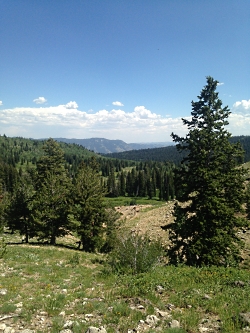
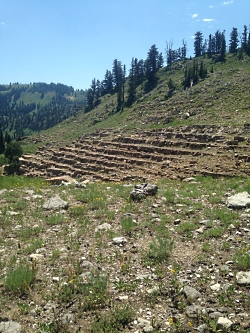 Devil’s Staircase, Tony Grove, Courtesy & Copyright Hilary Shughart
Devil’s Staircase, Tony Grove, Courtesy & Copyright Hilary Shughart
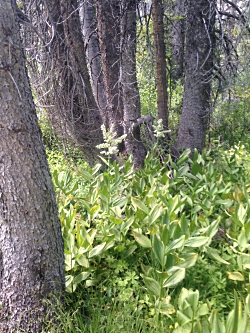 False Hellebore/Corn lily (Veratrum californicum), Tony Grove, Courtesy & Copyright Hilary Shughart
False Hellebore/Corn lily (Veratrum californicum), Tony Grove, Courtesy & Copyright Hilary Shughart
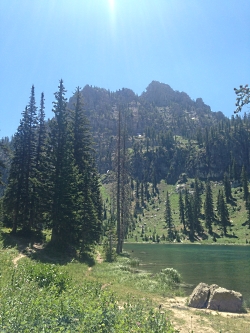 White Pine Lake and Mount Magog, Courtesy & Copyright Hilary Shughart
White Pine Lake and Mount Magog, Courtesy & Copyright Hilary Shughart
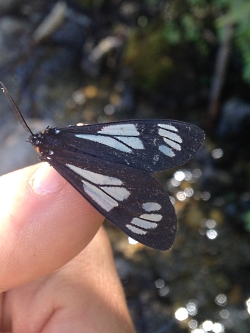 Police Car Moth on Rob Garrett’s thumb, White Pine Lake hike.
Police Car Moth on Rob Garrett’s thumb, White Pine Lake hike.
Courtesy & Copyright Hilary Shughart
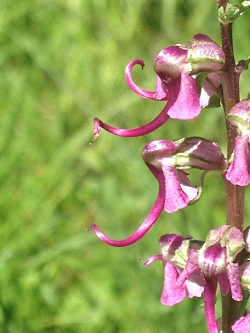 Elephanthead Lousewort (Pedicularis groenlandica), White Pine Lake hike.
Elephanthead Lousewort (Pedicularis groenlandica), White Pine Lake hike.
Courtesy & Copyright Hilary Shughart
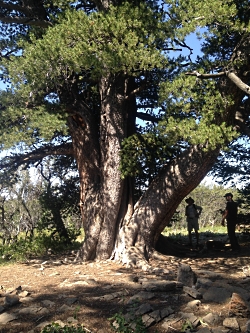 Rob & Jack & big tree, Limber Pine hike
Rob & Jack & big tree, Limber Pine hike
Courtesy & Copyright Hilary Shughart
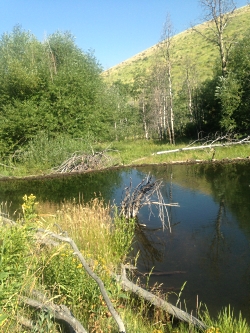 Beaver Dam at USU Forestry Camp (LCFS hike)
Beaver Dam at USU Forestry Camp (LCFS hike)
Courtesy & Copyright Hilary Shughart
 Jack in 560 year old Limber Pine tree 7/27/16
Jack in 560 year old Limber Pine tree 7/27/16
Courtesy & Copyright Hilary ShughartI just completed teaching a 5 day Utah Master Naturalist course through USU extension on Utah mountains. The course allowed me to revisit the immense influence these lofty lumps in the earth’s crust have had on my life, and the life of so many others.
It was mountains that drew me here from the flatlands of Michigan. They have become my main source of spiritual renewal, of aesthetic pleasure and recreation. I run, ski, and hike their trails, explore their hidden canyons and forests, revel in the rich tapestry of wildlife and wildflowers that adorns their slopes, and at present, need I say, seek relief from summer’s heat.
Having served 11 seasons as a seasonal Wilderness ranger for the USFS, I was able to explore much of the backcountry in the Bear River and Wellsville mountains of N. Utah. Beyond these, I’ve been atop Kings peak, the Lasals, Abajos, Cedar and Pine Valley Mountains, the Raft Rivers, and many of our high plateaus. But this is small potatoes considering Wikipedia lists 65 others yet to be explored in our state.
Mountains are what we are. Without them, Brigham Young and the Saints would have continued their exodus on to other parts of the west for the rich resources they bless us with.
Mountains = water. This liquid gift provides over 80% of Utah’s water as they do for most other western states. In the early years, they offered timber and rock for structures, including temples, tabernacles, and other historic buildings. Cool breezes followed canyons down to give relief from intense summer heat, and grew forage for cattle and sheep. The Oquirrh mountains on the west edge of Salt Lake valley are host to one of the world’s richest mines yielding approximately 25 percent of the country’s copper, 12 tons of gold, and 120 tons of silver each year.
Going beyond Utah and the west, it is water from mountain glaciers that support over 2 billion people in India, China and several middle east/Eurasian countries. With rapidly receding glaciers from a warming planet, this has become a grave concern.
On a lessor note, I recently accompanied a group of college students on a YNP pica inventory to follow their population trends as they are being impacted by a changing climate.
I’ll conclude with an 1877 quote from early American naturalist John Muir upon first entering the Salt Lake valley.
“The mountains rise grandly round about this curious city, the Zion of the new Saints, so grandly that the city itself is hardly visible. The Wasatch range, snow-laden and adorned with glacier-sculpted peaks, stretches continuously along the eastern horizon, forming the boundary of the Great Salt Lake basin; while across the valley of the Jordan southwestward from here, you behold the Oquirrh Range, about as snowy and lofty as the Wasatch.
The glacial developments of these superb ranges are sharply sculpted peaks and crests, with ample wombs between them where the ancient snows of the glacial period where collected and transformed into ice, and ranks of profound shadowy canyons, while moraines commensurate with the lofty fountains extend into the valleys, forming far the grandest series of glacial monuments I have yet seen this side of the Sierra.”
This is Jack Greene reading and writing for Wild About Utah.
Sacred Mountains-Credits:
Images: Courtesy and Copyright Hilary Shughart
Text: Jack Greene, Bridgerland Audubon Society
Sacred Mountains-Additional Reading:
Wasatch Mountains, History to Go, Utah.gov, https://historytogo.utah.gov/utah_chapters/the_land/wasatchmountains.html
Geology of Utah, History to Go, Utah.gov, https://historytogo.utah.gov/utah_chapters/the_land/geologyofutah.html
Logan Ranger District, USDA Forest Service, https://www.fs.usda.gov/recarea/uwcnf/recarea/?recid=8985
Hylland, Rebecca, What are Igneous, Sedimentary & Metamorphic Rocks?, Glad You Asked, Utah Geological Survey, https://geology.utah.gov/map-pub/survey-notes/glad-you-asked/igneous-sedimentary-metamorphic-rocks/
